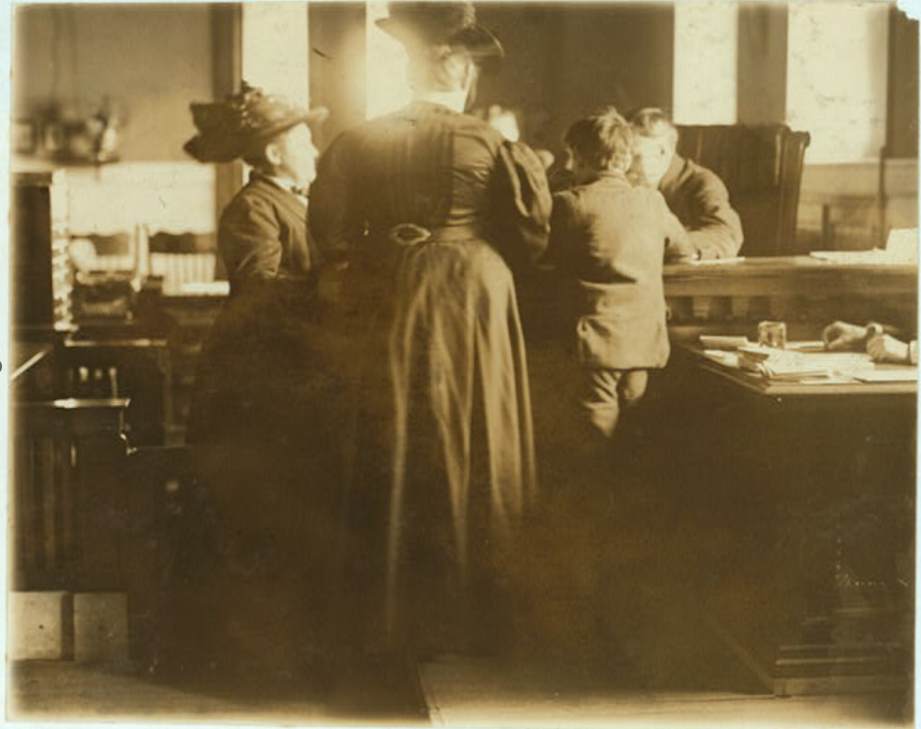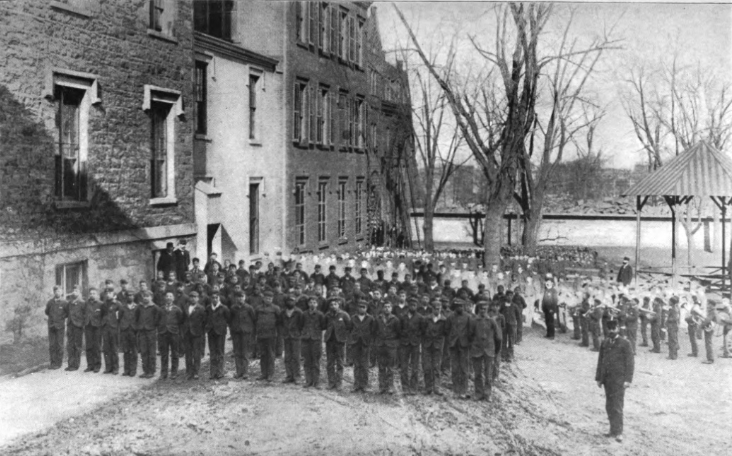“Dealing With Delinquency” in 1880-1940
Delinquency in of itself is a social construct. Its construction was asserted and applied to children in the era of the progressive child saving movement. It exists as it distinguishes between children of different circumstances along blurry lines. The reformers that sought to control delinquency and/or “save” children from it, constructed physical spaces to contain it.
Defining Delinquency
Anthony Platt (2009) reveals how the child saving movement of the progressive era influenced the development of the juvenile justice system in his book The child savers: The invention of delinquency. Partly coming out of widespread views that delinquents and criminals were a danger to society, the child savers found a way to construct reasons for saving the children. They believed that the only way to stop crime was to stop the production of criminals, however it was “not made clear how future criminals could be identified and who determines which children are redeemable” (Platt, 2009, p. 32). Erin Bush (2023) discusses in her journal article “For the Protection of Our Children” that the perception of delinquent children in Virgina was shaped around blaming inadequate parenting. There was a belief that delinquents and dependents would be a drain on the system. In this view, reformers in Virginia were not so concerned about the welfare of the poor, but the fact that the serious issues they dealt with could cause them to become a drain on the system, which led to a policy of prevention. Darwinism and eugenics were widely bought into at the time, and that informed views on juvenile delinquents in the sense that people believed that criminality could be and was genetically passed down (Platt, 2009, p. 27). This view provided pretense for how some children were identified as delinquent. The child savers, however, started advocating that there was a certain class of delinquents that could be saved if they were reached early enough (Platt, 2009, p. 32).
Intervention
Thus began an era of intervention in the lives of poor children and the construction of institutions that sought to reform and mold the behaviors of children. Bush extensively discusses the juvenile justice system’s intervention into the lives of poor children in the context of the Children’s Code, which was created in Virginia to handle dependent and delinquent children. The problem became that the process of identifying “dependents” is based in prejudice and diminishes autonomy of marginalized groups. Furthermore, the state also believed in parens patriae, the “idea that the state should function as the supreme protector or parent of its children” (Bush, 2023, p. 210), which provided pretense for justifying intervention in the lives of families. Child reformers used these ideas in their creation of the Children’s Code to expand the surveillance of the justice system to implement social control. John R. Sutton (1985) further demonstrates the implementation of social control in his journal article “The Juvenile Court and Social Welfare: Dynamics of Progressive Reform” as he explains that “the new court was an institutional compromise which drew on legal norms to provide a buffer of legitimacy within which discretionary social control activities… could be continued” (p. 109). Another function of the courts, as described by Sutton (1985) was “to specify formal definitions for delinquent and neglected (or dependent) children” (p. 116). These definitions, however, were vague and often blurred the line between dependent and delinquent children, as well as gave pretense for the courts to intervene in the lives of poor families.
The overlap of the dependent and delinquent labels created a widespread issue for marginalized children, especially Black children. The effect of the justice system on Black children is discussed in Tera Eva Agyepong’s (2018) book Criminalization of Black Children: Race, Gender, and Delinquency in Chicago’s Juvenile Justice System, 1899-1945. Throughout the first chapter, Agyepong discusses examples of Black dependent children being labeled as delinquent, the dearth of community resources for struggling Black folks, and the racialized notions of childhood. “Institutions intended for children who had committed crimes quickly became the primary mode of “care” for dependent black children” (Agyepong, 2018, p. 8). Segregation, and broader racist policies and attitudes thus resulted in the reliance on institutions intended for delinquency for these children. This is what Agyepong argues led to the disproportionate numbers of Black children represented as juvenile delinquents.
Institutional Responses

There were numerous institutional responses that intervened in the lives of children to “save them from delinquency.” One institution that was used to intervene in children’s lives was the juvenile court. The courts are discussed in The Failed Century of the Child: Governing America’s Young in the Twentieth Century by Judith Sealander (2003). Sealander explains that the juvenile courts came into being in the context of child reformers’ view that children needed to be separated from the corrupting influence of adult criminals. Furthermore, the child reformers believed that the courts could be used to “reach troubled children, not just children in trouble with the law” (Sealander, 2003, p. 21). Sealander goes on to explain the reformative intentions and implementations of the court. In this era, there were certainly efforts to reform the juvenile justice system, but the rehabilitative intentions were often not felt in practice (Sealander, 2003, pg. 29-30). Sutton (1985) corroborates this feeling as he says that “the court should not be understood as a sweeping reform in the treatment of children, but as a manifestation of a national trend toward bureaucratization and as an institutional compromise between law and social welfare” (p. 142). The courts were revolutionary in that they created a space for children to be on trial separate from the spaces for adults, but overall, it was just another institution meant to control children and mold them to fit into societal standards.

Hathi Trust: Annual report of the Children’s Village to the legislature of the State and to the Board of Aldermen of the City of New York for the year 1897
The courts had the authority to release children back to families, on probation, or to institutions such as reformatories, truant schools, or asylums or orphanages. Reformatories sprouted up as institutions to hold delinquent youth that would be less intense than traditional prisons. Platt (2009) explains that the reformatory plan was popular of the time, in which for institutions that held juvenile delinquents “restraint and discipline were an integral part of the ‘treatment’ program” (p. 73). The reformatory plan was rooted in nine values: segregation of children from corrupting influences of adult criminals, imprisonment for own good and protection; due process not required; indeterminate sentences; military drills to teach discipline and have structure; cottage plan in countryside because rural life was seen as pure; providing of elementary education /industrial and agricultural training, but nothing more advanced; and teaching of values of sobriety, thrift, industry, prudence, “realistic” ambition, and adjustment (Platt, 2009, p. 54). These values are evident of intentions to make children subservient and obedient. Regardless of the specific institution, these values were reflected.
Beyond physical spaces that were constructed to “deal with” “delinquent children,” police officers invaded the spaces that children interacted with in everyday life in the name of controlling delinquency. “’The Cop Will Get You’: The Police and Discretionary Juvenile Justice, 1890-1940” by David Wolcott (2001) shows what this looked like on the ground for children by way of policing. Juvenile courts arose as “the result of an emerging Progressive social philosophy that the state was responsible to intervene in children’s social and familial relations in order to rescue them from delinquency” (p. 350). The juvenile courts, however, relied on the police to put their goals into action (p. 352). The police were, in most cases, the first point of contact with the justice system for children, so how the police went about combatting juvenile delinquency was significant to the lives of children. “Arresting juvenile offenders was less a means of introducing them into the criminal justice system for punishment or rehabilitation, than of satisfying aggrieved citizens and of officially reprimanding disorderly youth” (Wolcott, 2001, p. 356). Cops largely policed delinquency as children were seen as nuisances up until the 1930s. The aim of eliminating nuisances illustrates adults not wanting children to be in public space. Wolcott provides numerous examples as to what “juvenile delinquents” got up to in order to be considered nuisances and find themselves being arrested as juvenile delinquents. Unlike adults, youth did not disrupt public peace by being drunk and disorderly, rather they were normally picked up for petty theft or truancy (Wolcott, 2001, p. 356).